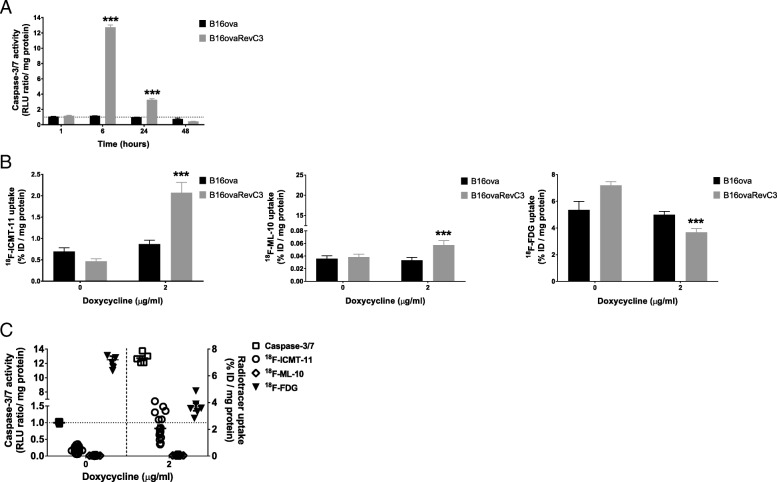Fig. 2.
In vitro caspase activity and uptake of radiotracers in response to death-switch induction. a Caspase-3/7 activity in B16ova and B16ovaRevC3 cells in response to various duration of exposure to doxycycline (2 μg/ml). Significantly increased caspase activity was observed in B16ovaRevC3 cells at 6 and 24 h compared with respective controls (13- and 3-fold increase, respectively) and compared with B16ova cells treated with doxycycline (p < 0.001, Student’s t test). b Radiotracer uptake was evaluated following treatment with doxycycline (2 μg/ml) for 6 h. There were no significant differences in the uptake of any of the radiotracers in B16ova cells. Significantly increased uptake of 18F-ICMT-11 (p < 0.001) and 18F-ML-10 (p < 0.05), and significantly decreased uptake of 18F-FDG (p < 0.001) was observed in B16ovaRevC3 cells after death-switch induction (two-way ANOVA). Significantly higher uptake of 18F-ICMT-11 (p < 0.001) and 18F-ML-10 (p < 0.01) and significantly lower uptake of 18F-FDG (p < 0.05) were observed in B16ovaRevC3 cells compared with B16ova cells treated with doxycycline (multiple t tests). c Caspase-3/7 activity correlated with increased 18F-ICMT-11 and decreased 18F-FDG uptake in B16ovaRevC3 cells after death-switch induction. Assays were conducted in triplicate using six replicates per experiment. Data are presented as mean ± SEM. * indicates significant difference between B16ova and B16ovaRevC3 treated with doxycycline; ** indicates significant difference between doxycycline-treated B16ovaRevC3 and untreated B16ovaRevC3; *** indicates significant difference between doxycycline-treated B16ovaRevC3 and untreated B16ovaRevC3, and doxycycline-treated B16ova

